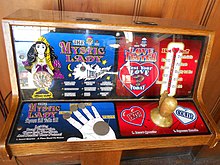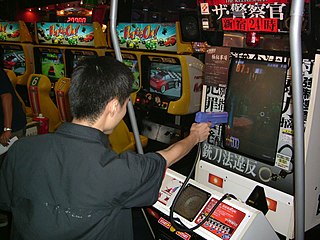
An arcade video game takes player input from its controls, processes it through electrical or computerized components, and displays output to an electronic monitor or similar display. All arcade video games are coin-operated or accept other means of payment, housed in an arcade cabinet, and located in amusement arcades alongside other kinds of arcade games. Until the early 2000s, arcade video games were the largest and most technologically advanced segment of the video game industry.

Fortune telling is the unproven spiritual practice of predicting information about a person's life. The scope of fortune telling is in principle identical with the practice of divination. The difference is that divination is the term used for predictions considered part of a religious ritual, invoking deities or spirits, while the term fortune telling implies a less serious or formal setting, even one of popular culture, where belief in occult workings behind the prediction is less prominent than the concept of suggestion, spiritual or practical advisory or affirmation.
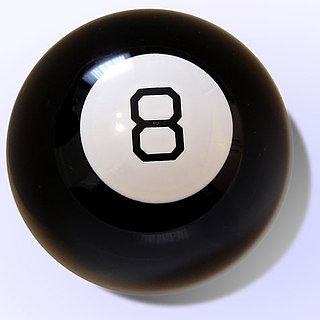
The Magic 8 Ball is a plastic sphere, made to look like an oversized eight ball, that is used for fortune-telling or seeking advice. It was invented in 1946 by Albert C. Carter and Abe Bookman and is currently manufactured by Mattel. The user asks a yes–no question to the ball, then turns it over to reveal an answer that floats up into a window.
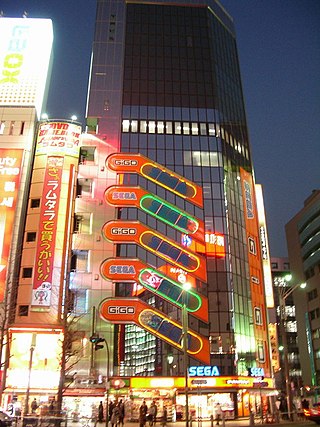
An amusement arcade, also known as a video arcade, amusements, arcade, or penny arcade, is a venue where people play arcade games, including arcade video games, pinball machines, electro-mechanical games, redemption games, merchandisers, or coin-operated billiards or air hockey tables. In some countries, some types of arcades are also legally permitted to provide gambling machines such as slot machines or pachinko machines. Games are usually housed in cabinets.

The Mutoscope is an early motion picture device, invented by W. K. L. Dickson and Herman Casler and granted U.S. patent 549309A to Herman Casler on November 5, 1895. Like Thomas Edison's Kinetoscope, it did not project on a screen and provided viewing to only one person at a time. Cheaper and simpler than the Kinetoscope, the system, marketed by the American Mutoscope Company, quickly dominated the coin-in-the-slot peep-show business.
Redemption games are typically arcade games of skill that reward the player proportionally to their score in the game. The reward most often comes in the form of tickets, with more tickets being awarded for higher scores. These tickets can then be redeemed at a central location for prizes. The most inexpensive prizes may require only a small number of tickets to acquire, while the most expensive ones may require several thousand. In general, the amount of money spent to win enough tickets for a given prize will exceed the value of the prize itself. Some redemption games, such as Flamin' Finger, involve elements of chance, which can be set by the operator.

A crystal ball is a crystal or glass ball commonly used in fortune-telling. It is generally associated with the performance of clairvoyance and scrying in particular. Other names include crystal sphere, gazing ball, shew stone, and show stone. In neopaganism it is sometimes called an orbuculum.

The Musée Mécanique is a for-profit interactive museum of 20th-century penny arcade games and artifacts, located at Fisherman's Wharf in San Francisco, California. With over 300 mechanical machines, it is one of the world's largest privately owned collections.

Love and Berry: Dress Up and Dance! is an arcade game and collectible card game from Sega, targeted toward girls. The game was first shown in amusement arcades on October 30, 2004, and became very popular among the target market in late 2005 through 2006. Game machines were installed in many department stores and children's play areas. Players receive 1 card at the start of the game with barcodes on them that stores information for new outfits, accessories, and hairstyles for the game characters. As of April 2006, there are 180 different collectible cards. As of January 2006, approximately 6,800 machines have been installed, and 104 million cards printed. It is the fourth trading card arcade game by Sega, following World Club Champion Football, Mushiking: The King of Beetles and The Key of Avalon.

Big The Musical is a 1996 musical adaptation of the 1988 film starring Tom Hanks. It was directed by Mike Ockrent and featured music by David Shire and lyrics by Richard Maltby, Jr., with choreography by Susan Stroman. It involves Josh Baskin, a 12-year-old boy who grows up overnight after being granted a wish by a Zoltar Speaks machine at a carnival. With the aid of his best friend, Billy, he must cope with his new adulthood while finding the machine so that he can wish himself back and more.

Many fictional depictions of the Roma in literature and art present Romanticized narratives of their supposed mystical powers of fortune telling, and their supposed irascible or passionate temper which is paired with an indomitable love of freedom and a habit of criminality. Critics of how the Roma have been portrayed in popular culture point out similarities to portrayals of Jewish people, with both groups stereotyped negatively as wandering, spreading disease, abducting children, and violating and murdering others.

The International Mutoscope Reel Company was an American amusement arcade company. They were formed in the early 1920s, to produce Mutoscope machines and the motion picture reels that the machines played. They continued to manufacture arcade machines, including the claw machine as well as electro-mechanical games, until 1949.
Is My Palm Read is a 1933 Pre-Code Fleischer Studios animated short film starring Betty Boop, and featuring Koko the Clown and Bimbo.
"In the Penny Arcade" is a short story by American writer Steven Millhauser. It is one of seven short stories previously published in the early 1980s in venues such as the New Yorker, Grand Street, Antaeus, and the Hudson Review. Like Millhauser's two novels, they are about the ability of artists and children to see things anew, to remake things through the force of their own romantic yearnings, and the dangerous consequences of that gift.

Fortune telling fraud, also called the bujo or egg curse scam, is a type of confidence trick, based on a claim of secret or occult information. The basic feature of the scam involves diagnosing the victim with some sort of secret problem that only the grifter can detect or diagnose, and then charging the mark for ineffectual treatments. The archetypical grifter working the scam is a fortune teller who announces that the mark is suffering from a curse that their magic can relieve, while threatening dire consequences if the curse is not lifted.

A love tester machine is a type of amusement personality tester machine, which upon receiving credit tries to rate the subject's sex appeal, love abilities or romantic feelings for someone. Many love testers measure the moisture on the skin surface of the subject's hands by electrically testing the skin conductance and rates accordingly. Others measure the temperature of the skin. However, some machines just use a random generator. Love meters could be found in penny arcades, and can be seen in modern video arcades, amusement parks, in bars and restaurants. Such vending machines are for amusement purposes only and do not actually give a real result. Nintendo, before entering the video game industry, released their own handheld love tester.

Big is a 1988 American fantasy comedy-drama film directed by Penny Marshall and stars Tom Hanks as Josh Baskin, a pre-adolescent boy whose wish to be "big" transforms him physically into an adult. The film also stars Elizabeth Perkins, David Moscow, John Heard, and Robert Loggia, and was written by Gary Ross and Anne Spielberg. It was produced by Gracie Films and distributed by 20th Century Fox.
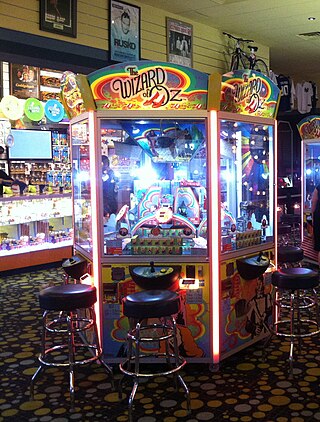
The Wizard of Oz is an arcade coin pusher game based on the 1939 film that awards token chips and cards that are redeemable for prizes. The player shoots coins into the machine which drops chips and cards. The player collects the cards and chips that can be redeemed later for prizes. The coins are retained by the machine. Most arcades that have this game will award a jackpot for collecting the entire series of cards. It can be played by up the six players. The game is developed by Elaut Belgium and released in the fall of 2010. According to the company's press release, the game was very well received by players and amusement centers.
Knott's Bear-y Tales was a dark ride located at Knott's Berry Farm that opened in 1975 as part of the Roaring 20s area. The attraction was designed by Disney Imagineer Rolly Crump as part of creating a ride that would complement Gypsy Camp, a former themed area of the park. However, the dwindling Gypsy Camp would end up becoming a new section called the Roaring 20s. As a result, the design of Bear-y Tales was altered twice until it ended up reflecting the theme of the Roaring 20s area. During construction, the building caught on fire and a couple of scenes that were under development were destroyed. However, the attraction was given an extended deadline to allow more time and reconstruction of the damaged parts of the ride. In the fall of 1986, Knott's Bear-y Tales was closed to become Kingdom of the Dinosaurs due to the then-upcoming trend of dinosaurs. Following the closure, many of the animatronics and set pieces were obtained by employees, while others stayed within Knott's to become a part of a walk-through experience in 1987 located at the Camp Snoopy area. That attraction also closed and was removed in 1998.

An arcade game or coin-op game is a coin-operated entertainment machine typically installed in public businesses such as restaurants, bars and amusement arcades. Most arcade games are presented as primarily games of skill and include arcade video games, pinball machines, electro-mechanical games, redemption games or merchandisers.

